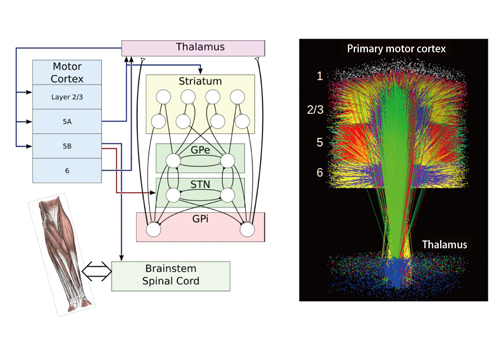Development of a central nervous system model for elucidating the onset mechanism of Parkinson’s disease


Fig. :Left: Schematic illustration of the connections between the basal ganglia, thalamus and cerebral cortex
Right: Three-dimensional illustration of the planned neural circuit model between the cerebral cortex and the thalamus
We are conducting simulation studies of the brain by using the K computer to elucidate the mechanisms whereby Parkinsonian symptoms develop, and investigate an effective remedy. Parkinson’s disease is a disorder of the central nervous system and causes various symptoms mainly related to movement, such as slowness of movement, shaking of the body, muscle rigidity, and difficulty in maintaining posture. Parkinson’s disease is the second most common neurodegenerative disease after Alzheimer’s disease, and affects several million people in the world.
The cause of Parkinson’s disease is loss of dopamine-generating cells in the substantia nigra compacta, the causes of which have been suggested to be mitochondria abnormality, and the effects of reactive oxygen. The resultant dopamine depletion triggers an abnormal and strong synchronous nervous activity of about 8-14Hz in the basal ganglia. The basal ganglia is interconnected with the thalamus and cerebral cortex forming a loop (basal ganglia→thalamus→cerebral cortex→basal ganglia); and the entire circuit is in charge of processing information that controls voluntary movement, etc. The abnormal synchronous nervous activity in the basal ganglia in Parkinson’s disease is believed to affect the entire loop, inhibiting normal information processing and causing various symptoms. However, it is still poorly understood how the basal ganglia, thalamus and cerebral cortex affect each other and cause the various symptoms of Parkinson’s disease. Factors obstructing elucidation of the mechanism include the limited number of nerve cells and the limited range of the brain that can be actually monitored, and the difficulty of measuring the interactions among nerve cells, which are connected in a complex way.
In brain simulation, the activities of all nerve cells and interactions are recorded, and the nerve activities can be investigated repeatedly for various conditions. We aim to simulate the entire nerve circuit of the basal ganglia, thalamus and cerebral cortex, and investigate their mutual interactions by using the enormous arithmetic capacity of the K computer, and investigate and improve deep brain stimulation and other remedies. At present, we are developing models of the basal ganglia, thalamus and cerebral cortex, separately. The basal ganglia is being modeled so as to reproduce the abnormal synchronous nervous activity. The pathological neural oscillation in Parkinsonian disease has been successfully reproduced by imitating the characteristics of nerve cells and synapses in the subthalamic nucleus and globus pallidus lateral segment under dopamine depletion. The thalamus and cerebral cortex are being modeled, focusing on elucidating the mechanism of Parkinsonian tremor. The tremor is known to synchronize with the neural oscillation (about 10Hz) at the thalamus and cerebral cortex, but at a half of the cycle. We are developing a neural circuit model of the thalamus that can reproduce the oscillation, and a model of the cerebral cortex that expresses the body movements involved in tremor. We are also testing the entire model that connects the models of the basal ganglia, thalamus and cerebral cortex. At the final stage, we are planning to evaluate the development mechanism of Parkinsonian symptoms by using a model of the whole body, which includes the spinal cord and musculoskeletal models that feed back sensory signals to the brain.


















